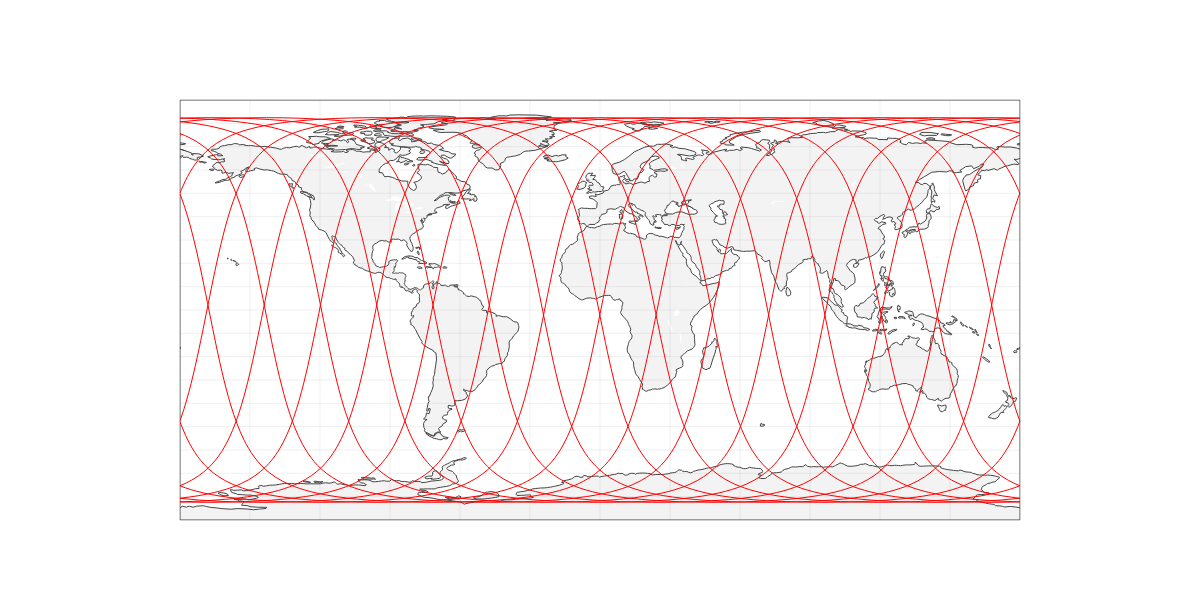Orbit Computation¶
This tutorial demonstrates how to generate satellite orbits using various models.
Setup¶
import numpy as np
import pandas as pd
import plotly.graph_objs as go
from ostk.physics.unit import Length
from ostk.physics.unit import Angle
from ostk.physics.time import Scale
from ostk.physics.time import Instant
from ostk.physics.time import Duration
from ostk.physics.time import Interval
from ostk.physics.time import DateTime
from ostk.physics import Environment
from ostk.astrodynamics.trajectory import Orbit
from ostk.astrodynamics.trajectory.orbit.model import Kepler
from ostk.astrodynamics.trajectory.orbit.model.kepler import COE
from ostk.astrodynamics.trajectory.orbit.model import SGP4
from ostk.astrodynamics.trajectory.orbit.model.sgp4 import TLE
from ostk.astrodynamics.utilities import convert_state
from ostk.astrodynamics.display import create_2d_map
from ostk.astrodynamics.display import create_3d_globe
SGP4¶
Computation¶
environment = Environment.default()
Create a Classical Orbital Element (COE) set:
a = Length.kilometers(7000.0)
e = 0.0001
i = Angle.degrees(35.0)
raan = Angle.degrees(40.0)
aop = Angle.degrees(45.0)
nu = Angle.degrees(50.0)
coe = COE(a, e, i, raan, aop, nu)
Setup a Keplerian orbital model:
epoch = Instant.date_time(DateTime(2018, 1, 1, 0, 0, 0), Scale.UTC)
earth = environment.access_celestial_object_with_name("Earth")
keplerian_model = Kepler(coe, epoch, earth, Kepler.PerturbationType.No)
Create a Two-Line Element (TLE) set:
tle = TLE(
"1 39419U 13066D 18260.77424112 .00000022 00000-0 72885-5 0 9996",
"2 39419 97.6300 326.6556 0013847 175.2842 184.8495 14.93888428262811",
)
Setup a SGP4 orbital model:
sgp4_model = SGP4(tle)
Setup the orbit:
# orbit = Orbit(keplerian_model, environment.access_celestial_object_with_name("Earth"))
orbit = Orbit(sgp4_model, environment.access_celestial_object_with_name("Earth"))
Now that the orbit is set, we can compute the satellite position:
start_instant = Instant.date_time(DateTime(2018, 9, 5, 0, 0, 0), Scale.UTC)
end_instant = Instant.date_time(DateTime(2018, 9, 6, 0, 0, 0), Scale.UTC)
interval = Interval.closed(start_instant, end_instant)
step = Duration.minutes(1.0)
Generate a time grid:
instants = interval.generate_grid(step)
states = [[instant, orbit.get_state_at(instant)] for instant in instants]
orbit_data = [convert_state(state) for state in states]
---------------------------------------------------------------------------
AttributeError Traceback (most recent call last)
Cell In[13], line 1
----> 1 orbit_data = [convert_state(state) for state in states]
Cell In[13], line 1, in <listcomp>(.0)
----> 1 orbit_data = [convert_state(state) for state in states]
File /usr/local/lib/python3.11/dist-packages/ostk/astrodynamics/utilities.py:236, in convert_state(state)
212 def convert_state(
213 state: State,
214 ) -> tuple[str, float, float, float, float, float, float, float, float, float]:
215 """
216 Convert a State into dataframe-ready values.
217 - Instant (str)
(...)
233 tuple[str, float, float, float, float, float, float, float, float, float]: The dataframe-ready values.
234 """
--> 236 lla: LLA = lla_from_state(state)
238 instant: Instant = state.get_instant()
240 return (
241 str(instant.to_string()),
242 float(instant.get_modified_julian_date(Scale.UTC)),
(...)
247 float(lla.get_altitude().in_meters()),
248 )
File /usr/local/lib/python3.11/dist-packages/ostk/astrodynamics/utilities.py:36, in lla_from_state(state)
25 def lla_from_state(state: State) -> LLA:
26 """
27 Return latitude (degrees), longitude (degrees), altitude (meters) float list from a state.
28
(...)
33 LLA: The LLA.
34 """
---> 36 return lla_from_position(state.get_position(), state.get_instant())
AttributeError: 'list' object has no attribute 'get_position'
orbit_df = pd.DataFrame(
orbit_data,
columns=[
"$Time^{UTC}$",
"$MJD^{UTC}$",
"$x_{x}^{ECI}$",
"$x_{y}^{ECI}$",
"$x_{z}^{ECI}$",
"$v_{x}^{ECI}$",
"$v_{y}^{ECI}$",
"$v_{z}^{ECI}$",
"$Latitude$",
"$Longitude$",
"$Altitude$",
],
)
Output¶
Table:
orbit_df.head()
| $Time^{UTC}$ | $MJD^{UTC}$ | $x_{x}^{ECI}$ | $x_{y}^{ECI}$ | $x_{z}^{ECI}$ | $v_{x}^{ECI}$ | $v_{y}^{ECI}$ | $v_{z}^{ECI}$ | $Latitude$ | $Longitude$ | $Altitude$ | |
|---|---|---|---|---|---|---|---|---|---|---|---|
| 0 | 2018-09-05 00:00:00 [UTC] | 58366.000000 | -1.713399e+06 | 4.882015e+05 | 6.729062e+06 | -4963.295593 | 5457.439154 | -1666.177507 | 75.158968 | -179.618850 | 602749.955899 |
| 1 | 2018-09-05 00:01:00 [UTC] | 58366.000694 | -2.007361e+06 | 8.143839e+05 | 6.614883e+06 | -4831.972213 | 5411.464113 | -2138.444901 | 71.875980 | 173.964827 | 601723.868966 |
| 2 | 2018-09-05 00:02:00 [UTC] | 58366.001389 | -2.292825e+06 | 1.137119e+06 | 6.472626e+06 | -4680.139327 | 5342.558791 | -2601.814472 | 68.453880 | 169.415947 | 600586.133346 |
| 3 | 2018-09-05 00:03:00 [UTC] | 58366.002083 | -2.568580e+06 | 1.455038e+06 | 6.302882e+06 | -4508.419228 | 5250.994715 | -3054.324538 | 64.948448 | 166.007089 | 599350.279488 |
| 4 | 2018-09-05 00:04:00 [UTC] | 58366.002778 | -2.833452e+06 | 1.766793e+06 | 6.106362e+06 | -4317.518408 | 5137.138312 | -3494.054108 | 61.389166 | 163.333225 | 598031.727629 |
2D plot, over World Map:
figure = create_2d_map(
data=go.Scattergeo(
lon=orbit_df["$Longitude$"],
lat=orbit_df["$Latitude$"],
mode="lines",
line=go.scattergeo.Line(width=1, color="red"),
),
)
figure.layout.update(
{
"width": 1200,
"height": 600,
}
)
figure.show("png")

3D plot, in Earth Fixed frame:
figure = create_3d_globe(
data=[
go.Scattergeo(
lon=orbit_df["$Longitude$"],
lat=orbit_df["$Latitude$"],
mode="lines",
line=go.scattergeo.Line(width=2, color="rgb(255, 62, 79)"),
)
],
)
figure.layout.update(
{
"width": 1200,
"height": 600,
}
)
figure.show("png")

3D plot, in Earth Inertial frame:
theta = np.linspace(0, 2 * np.pi, 30)
phi = np.linspace(0, np.pi, 30)
theta_grid, phi_grid = np.meshgrid(theta, phi)
r = float(earth.get_equatorial_radius().in_meters())
x = r * np.cos(theta_grid) * np.sin(phi_grid)
y = r * np.sin(theta_grid) * np.sin(phi_grid)
z = r * np.cos(phi_grid)
earth_surface = go.Surface(x=x, y=y, z=z, colorscale="Viridis", showscale=False)
trace = go.Scatter3d(
x=orbit_df["$x_{x}^{ECI}$"],
y=orbit_df["$x_{y}^{ECI}$"],
z=orbit_df["$x_{z}^{ECI}$"],
mode="lines",
marker=dict(
size=0, color=orbit_df["$x_{z}^{ECI}$"], colorscale="Viridis", showscale=False
),
line=dict(color=orbit_df["$x_{z}^{ECI}$"], width=1),
)
figure = go.Figure(
data=[earth_surface, trace],
layout=go.Layout(
title=None,
width=800,
height=1000,
showlegend=False,
scene=go.layout.Scene(
xaxis=dict(
gridcolor="rgb(255, 255, 255)",
zerolinecolor="rgb(255, 255, 255)",
showbackground=True,
backgroundcolor="rgb(230, 230,230)",
),
yaxis=dict(
gridcolor="rgb(255, 255, 255)",
zerolinecolor="rgb(255, 255, 255)",
showbackground=True,
backgroundcolor="rgb(230, 230,230)",
),
zaxis=dict(
gridcolor="rgb(255, 255, 255)",
zerolinecolor="rgb(255, 255, 255)",
showbackground=True,
backgroundcolor="rgb(230, 230,230)",
),
camera=dict(
up=dict(x=0, y=0, z=1),
eye=dict(
x=-1.7428,
y=1.0707,
z=0.7100,
),
),
aspectratio=dict(x=1, y=1, z=1),
aspectmode="manual",
),
),
)
figure.show("png")
